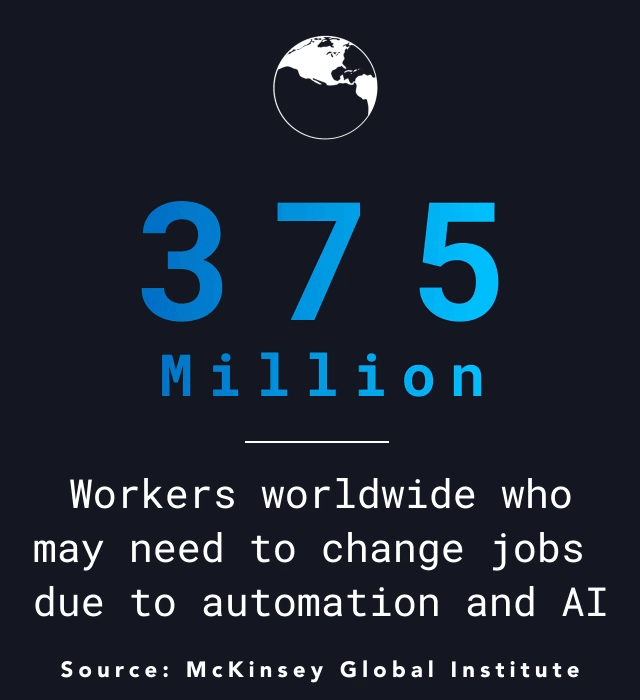For executives grappling with the changes that automation and artificial intelligence (AI) will bring to the workforce, one of the biggest questions—and uncertainties—is about what it will take to help workers make the transition.

However, while most executives know training is a big part of the AI readiness equation, they’re unsure how to build a training program that will yield results. In a recent McKinsey survey, 82% of executives said retraining and “re-skilling” are half the answer for addressing the skills gap, along with recruiting.
Yet they don’t think they’re at all ready to take on this challenge. Just 16% of private-sector business leaders feel “very prepared” to address skills gaps, with roughly twice as many feeling either “somewhat unprepared” or “very unprepared.”
Creating re-skilling programs for the AI era requires corporate leaders to take a strategic approach to HR and think through what their businesses will look like 10 years out. Executives recognize that the burden of training AI-literate workers is on them: 64% of U.S. leaders say they believe that corporations—not governments, educators or individual workers—should take the lead in closing the skills gap.
To Get Training Right, Rethink Your AI Future
Chief human resources officers (CHROs) and other executives should be projecting how their “digital transformation” will look in five or 10 years, and align training programs to those future needs. Executives’ feelings of unpreparedness noted in the McKinsey survey may stem from a lack of visibility about how their businesses will embrace AI.The most important step is to have clarity on the skills embedded in the workforce today, and how the workforce of the future will look in terms of size, composition and skill requirements. Without this clarity, companies risk offering training and education programs that do not fill the most critical skills gaps.
I have seen some companies do retraining well, but the playbook can differ among sectors. While financial services companies think through how automation can manage tasks associated with loan underwriting and banking, retailers, in a sector going through serious upheaval, are trying to understand how digital retail models will play alongside physical stores—and, therefore, how to retrain workers to be digital experts.
Without this knowledge, you can’t decide on a structure for a learning program. Envision where your company is going: Only then can you imagine the job roles you’ll add to the business, and the skill sets employees will need for success.
The value of looking at the long-term automated future of your business is that you can identify who doesn’t need to be retrained or re-skilled—which can be as important as knowing where retraining for AI skills will be mandatory. This is an ongoing discussion at McKinsey and with our clients: Across industries, 2% of your employees drive the most value to the rest of the organization. If a learning program is rolled out incrementally, those value drivers should be the first targets for re-skilling.
Seeking Partnerships From Inside And Outside The Business
Launching a successful retraining program requires buy-in across departments. The process can’t be driven by just HR, or just operations, or any other team trying to do it alone. The CHRO, CEO and CFO must all work together to drive this change.We call this the new “G3” of corporate leadership. CEOs will need to drive retraining, of course, as they set the overall company strategy. The CFO is necessary to provide the financial view on budgeting needs—and give a green light to the additional investment that retraining programs require. And the CHRO is clearly the one responsible for designing and delivering programs and career pathways that tie in with the larger automation strategy.
The most important step is to have clarity on the skills embedded in the workforce today, and how the workforce of the future will look in terms of size, composition and skill requirements.While some companies including Walmart are focusing on in-house retraining efforts, others supplement internal programs with training expertise from outside the business. AT&T, recognizing that its shift from phone company to data-powered entertainment and business solution company required massive workforce retraining, partnered with 32 colleges and universities and several online platforms to help employees obtain the skills needed for new digital roles.
Working with the Georgia Institute of Technology, the company created an online master’s degree in programming, as well as “Nanodegree” programs on the Udacity online platform that offer shorter-term but targeted classes for skills such as data analytics. What’s more, AT&T pays employee tuition for the courses.
The company says that as of early 2018, more than half its employees have completed 2.7 million online courses. It also reports that retrained workers are twice as likely to obtain technology and operations management roles than non-retrained workers.
AI transformations are complicated and take time to put in place. Yet the transitions are coming faster than we’ve experienced in previous periods of technological innovation, and the time to start planning is now. Reskilling may seem daunting, but coal miners in Kentucky can be retrained to write code that could apply machine learning to coal-country businesses, as Bit Source is doing—it’s an achievable goal for businesses of any size. The good news is that the focus on workforce skills of the future—needed to kick off any serious retraining initiative—is useful to encourage any company to reconsider its overall automation strategy in this time of rapid technological transformation.
CREDITS: Yuri_Arcurs/Getty
About the Author

No comments:
Post a Comment